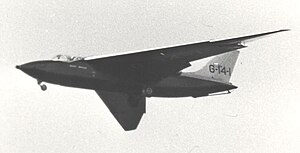| SB.4 Sherpa | |
|---|---|
 Short Sherpa demonstrating at the Farnborough SBAC Show in September 1954 | |
| General information | |
| Type | Experimental aircraft |
| National origin | United Kingdom |
| Manufacturer | Short Brothers |
| Designer | |
| Primary users | College of Aeronautics (Cranfield) |
| Number built | 1 |
| History | |
| First flight | 4 October 1953 |
| Developed from | Short SB.1 |
The Short SB.4 Sherpa was an experimental aircraft designed and produced by the British aircraft manufacturer Short Brothers. Only a single example was ever produced.
The Sherpa was developed during the 1950s for the purpose of testing a novel wing design, referred to as an aero-isoclinic wing. It was believed that this wing design could possess favourable qualities for producing tailless aircraft, and that the Sherpa would validate the characteristics of the wing for such aircraft to be produced in the future. While such a wing had been flown on the earlier Short SB.1, an unpowered glider, it was deemed valuable to use a powered aircraft instead. The design of the Sherpa is largely based upon that of the SB.1, to the extent that it incorporated numerous elements of this aircraft.
The Sherpa performed its maiden flight on 4 October 1953, after which it spent several years performing experimental flights and the occasional aerial display. After gathering sufficient data for Shorts' purposes, the company decided that it did not show sufficient potential as to continue its research into the aero-isoclinic wing. The sole Sherpa was donated to the College of Aeronautics at Cranfield during the late 1950s and flown for numerous years. It was eventually grounded and used as a static laboratory specimen at the Bristol College of Advanced Technology, before being preserved and put on display at the Norfolk and Suffolk Aviation Museum.